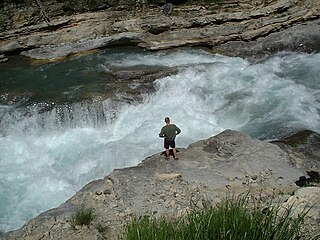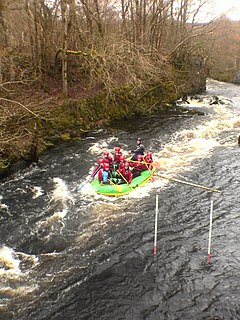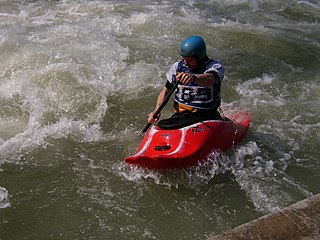
Whitewater forms in a rapid context, in particular, when a river's gradient changes enough to generate so much turbulence that air is trapped within the water. This forms an unstable current that froths, making the water appear opaque and white.

The Tryweryn is a river in the north of Wales which starts at Llyn Tryweryn in the Snowdonia National Park and after 19 kilometres (12 mi) joins the river Dee at Bala. It is one of the main tributaries of the Dee and it was dammed in 1965 to form Llyn Celyn, drowning the village of Capel Celyn in spite of much popular and political opposition in Wales. The resulting graffito "Cofiwch Dryweryn" near Llanrhystud became and remains a popular icon of Welsh feeling. Water is stored in Llyn Celyn in winter when flows are high, and released over the summer to maintain the flow in the Dee (water from the Dee is used as the water supply for large areas of north-east Wales, and for the Wirral and much of Liverpool in England.

An artificial whitewater course (AWWC) is a site for whitewater canoeing, whitewater kayaking, whitewater racing, whitewater rafting, playboating and slalom canoeing with artificially generated rapids.

The Hog's Back Falls, officially known as the Prince of Wales Falls, but rarely referred to by this name, are a series of artificial waterfalls on the Rideau River in Ottawa, Ontario, Canada. The falls are located just north of Mooney's Bay and the point where the Rideau Canal splits from the Rideau River.

The U.S. National Whitewater Center (USNWC) is a not-for-profit outdoor recreation and athletic training facility for whitewater rafting, kayaking, canoeing, rock climbing, mountain biking hiking and ice skating which opened to the public on 2006. The Center is located in Charlotte, North Carolina on approximately 1,300 acres (530 ha) of land adjacent to the Catawba River, with more than 45 miles (72 km) of developed trail.

The Kananaskis River is a mountain river in western Alberta, Canada. It is a tributary of the Bow River, crossing the length of Kananaskis Country.

Canolfan Tryweryn is the National White Water Centre for Wales, and is based near Bala in North Wales. It developed the first commercial white water rafting operation in the UK in 1986, and since then has grown to become the largest and one of the most well-known rafting organisations in the UK. The centre is home to paddlesport National Governing Body Canoe Wales. The National White Water Centre is ideal for canoeing, kayaking, play-boating and coached groups who sometimes run BCU/CW Star Awards.

Creeking is a branch of canoeing and kayaking that involves descending very steep low-volume whitewater. It is usually performed in specialized canoes and kayaks specifically designed to withstand the extreme whitewater environment in which the activity occurs. In addition, the canoes and kayaks give the paddler improved performance and maneuverability needed to avoid river obstacles.

River surfing is the sport of surfing either standing waves, tidal bores or upstream waves in rivers. Claims for its origins include a 1955 ride of 2.4 km (1.5 mi) along the tidal bore of the River Severn.

The Bitches are a tidal race and set of rocks between Ramsey Island and the west Welsh coastline near St Davids. They are a popular tourist destination and a playspot for extreme sports enthusiasts such as whitewater kayakers and surfers.

Sunbury Lock is a lock complex of the River Thames in England near Walton-on-Thames in north-west Surrey, the third lowest of forty four on the non-tidal reaches. The complex adjoins the right, southern bank about 1⁄2 mile (0.80 km) downstream of the Weir Hotel.

Hurley Lock is a lock and weir on the River Thames in England, situated in a clump of wooded islands close to the village of Hurley, Berkshire. The lock was first built by the Thames Navigation Commissioners in 1773.

The River Thames in England is a very popular river for kayakers and canoeists, and is home to several canoe clubs, including the Royal Canoe Club which is the oldest canoe club in the world.

The Dickerson Whitewater Course, on the Potomac River near Dickerson, Maryland, was built for use by canoe and kayak paddlers training for the 1992 Olympic Games in Spain. It was the first pump-powered artificial whitewater course built in North America, and is still the only one anywhere with heated water. It remains an active training center for whitewater slalom racing, swiftwater rescue training, and other whitewater activities.
Rutherford Creek is a tributary of the Green River, British Columbia, Canada, entering that river a few miles above Nairn Falls Provincial Park, near the village of Pemberton. The creek's headwaters are on the eastern side of the Pemberton Icefield, from where it flows southeast for the first half of its course, then generally east for the remainder. It is approximately 24 km (15 mi) in length. The mouth is at 50° 16' 3" N, 122° 57' 41" W.

Whitewater canoeing is the sport of paddling a canoe on a moving body of water, typically a whitewater river. Whitewater canoeing can range from simple, carefree gently moving water, to demanding, dangerous whitewater. River rapids are graded like ski runs according to the difficulty, danger or severity of the rapid. Whitewater grades range from I or 1 to VI or 6. Grade/Class I can be described as slightly moving water with ripples. Grade/Class VI can be described as severe or almost unrunnable whitewater, such as Niagara Falls.

The following outline is provided as an overview of canoeing and kayaking:

Lac Deschênes is a 44 kilometres long lake on the Ottawa River that runs from the Chats Falls Dam near Fitzroy Harbour in the west to the Deschênes Rapids at Britannia in the east. It is a little over 3.2 kilometres wide at its widest point and little more than a few hundred metres at its narrowest. The provincial border between Ontario and Quebec runs through the length of the lake with the City of Ottawa on its southern shore and the city of Gatineau on much of its northern shore. It is officially known by the French name only.



















